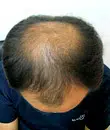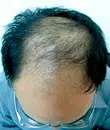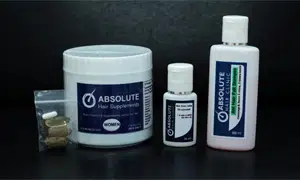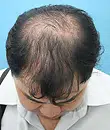What are the current medical treatments available?
Finasteride (Propecia®, Proscar®), an oral medication available by prescription only, has been introduced to the market in the past decade. Finasteride is approved only for use by men. Through scientific studies, it has been shown to re-grow hair in a significant number of men and stop hair loss in an even higher percentage. Finasteride works by decreasing the formation of DHT, a hormone responsible in large part for male pattern hair loss, while not reducing testosterone, the overall male hormone responsible for masculinity. Therefore, any side effects that may involve male sexual function are mild and occur in less than 2% of all patients.
Finasteride has been available for over 10 years and has been shown to be safe and effective. Finasteride (Propecia, Proscar) works best for early or moderate hair loss, but it may also help patients with more advanced hair loss to preserve their remaining hair, and its use is suggested by hair restoration surgeons as an effective medication to slow down or reverse male pattern hair loss in many men. It is often used as a complementary treatment for hair transplant patients. Topical minoxidil (Rogaine) has been around for over 15 years and is helpful in slowing down hair loss, but less effective in helping new hair to grow. A higher concentration (5% solution) of minoxidil is now available for men and has been shown to be more effective than the 2% solution. 5% minoxidil solution is generally not recommended for use by women because it may stimulate the growth of facial hair, and also because at least one study suggests that it is not more effective than the 2% in females.
Both finasteride and minoxidil must be used on a continual basis in order to sustain results, and if discontinued, the process of balding resumes. These medications may not work for everyone, but they have a proven track record that shows a significant benefit to many people. In addition, combination treatment with minoxidil solution and finasteride may provide added benefit for men with androgenetic alopecia.
A third drug, dutasteride, is in clinical trials. Similar to finasteride in action, it has been approved in Europe for use in hair restoration and is sometimes prescribed “off-label” for that purpose in the U.S. Under the brand name Avodart, dutasteride is approved in the U.S. for treatment of benign prostatic hypertrophy (prostate enlargement) in men.
Combined Surgical and Medical Hair Restoration Therapy: A Comprehensive Approach
Medical hair restoration therapy and hair transplantation are two different approaches to the correction of hair loss due to androgenetic alopecia. Either medical or surgical hair restoration may be the best approach to hair loss for an individual, depending on variable factors such as degree of hair loss, rapidity of hair loss, pattern of hair loss, and response to medical treatment. Some persons may benefit from a carefully controlled use of both medical hair restoration therapy and hair transplantation, under the supervision of a physician hair restoration specialist.
Combined Medical Hair Restoration Therapy and Hair transplantation Requires Planning and Commitment
While the possible benefit of combined medical hair restoration therapy and hair transplantation may be attractive, it is a choice that must be based on carefully considered factors. For example:
- The patient must have an acceptable response to medical hair restoration therapy in slowing of hair loss and/or stimulation of new hair growth. Some patients respond well, some less well, some poorly.
- As with all medications, the best result is obtained when the patient complies with instructions for use. Poor compliance can significantly alter benefit. A patient may become discouraged if benefit does not appear to be rapidly or consistently apparent; the patient should discuss this with the physician hair restoration specialist rather than unilaterally altering dose or timing of the hair restoration agent.
Is Hair Transplantation Needed If Medical Hair restoration Therapy is Successful?
Clinical trials of minoxidil and finasteride have shown patterns of benefit, or lack of benefit, for both agents. Some persons who respond well to a pharamcologicl hair restoration agent—with slowing of hair loss and/or stimulation of new hair growth—may not seek hair transplantation if the outcome of medical hair restoration therapy is satisfactory. Some of these persons may eventually consider hair transplantation if the medical hair restoration benefit is not maintained over time.
In Summary
For the properly selected patient, combined surgical and medical approached to hair restoration is likely to yield excellent results over the lifetime of the patient. Results of minoxidil and finasteride clinical trials and treatment indicate that use of a medical agent in a responsive patient will have a satisfactory response with minimal side effects that complements surgical therapy.
Result of medical treatment










